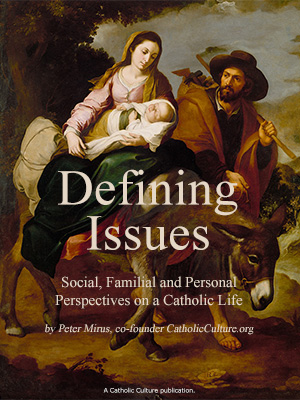Catholic Activity: The Crucifix as a Sacramental
The crucifix, another sacramental, should be hung in a prominent place in every room of a Catholic home. Therese Mueller discusses the significance and importance of your family crucifix.
DIRECTIONS
It was a custom with my forbears that before a new house was taken over, the father of the family would take time out before the movers arrived, to carry in the first "inhabitant," the Crucified, on a prayerful round from basement to top floor, and then to install the cross into its place of honor. So the Lord and Master was already there when the furnishings were moved in and the people arrived. I know of no better way to express so simply as well as fervently: "All that is mine is yours, O Lord. Take possession of all that we are and all that we have for the service of thy kingdom. Be the head of this house and this family." And as new families in the next generation took possession of their new homes, they too managed to carry in first the sacred symbol of our salvation and our hope, the cross, and to make this act a fervent vow of dedication and devotion.
The image of our Lord on the cross is in itself always a sacred sign. But the blessing of the Church bestows upon it spiritual power of protection and grace, making the image into a sacramental which recalls (to all who are willing to listen and to understand) the victory of Christ on the cross, the redemption through his death.
The sacred season of Lent and Easter, turning our gaze and our prayer ever so often to the holy cross, is a fitting time to add to the crucifixes in our house, until every room gets its share in the sacramental protection and graces.
Simple crosses can be cut from wood and, after finishing, can be painted with a symbol of Christ, his name or initials or any significant letters ("Life and Light," or "Way, Truth, Life"). A little more elaborate is the affixing of a flat-board body, either of the suffering or triumphant Christ, with a minimum of "natural" features engraved with a burning needle. If we do not care actually to make a cross, we might search for one that is a fine piece of art, each contributing to the expense and establishing it as a family heirloom, to represent our high esteem and devotion to the sign of salvation. In any case, let us make sure that the crosses in our house are blessed by a priest. There is one time when we are most in need of this blessing: when our last hour has begun. I like to think that any cross in our home, taken from the wall and lifted to our dying lips, will be a means to strengthen our faith and to achieve total surrender to the will of God, a powerful support to endure to the end—which in truth is the very beginning of life everlasting.
There is another thought that Mother Church passes on to us in Passiontide. When she covers the sacred image with purple cloth she seems to suggest that for a while we should deny ourselves even the consolation of gazing at the sacred images; but she does this looking forward to the unveiling on Good Friday, so that it will impress us all the more deeply with a new emphasis. Even in our living room this temporary change of an all-too-familiar sight, this covering with a penitential cloth, will work for a more vivid awareness of Christ's presence as Lord of the house, on Good Friday as well as all through the Easter season.
Activity Source: Little Sacraments, The: Liturgy for the Home by Therese Mueller, Conception Abbey Press, Conception, Missouri, 1961






